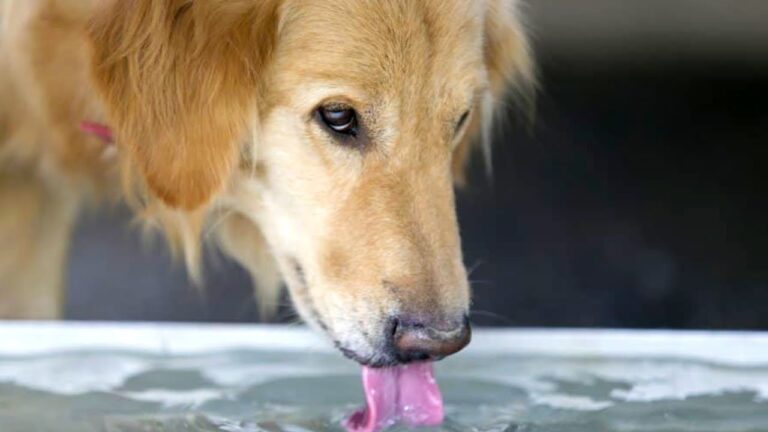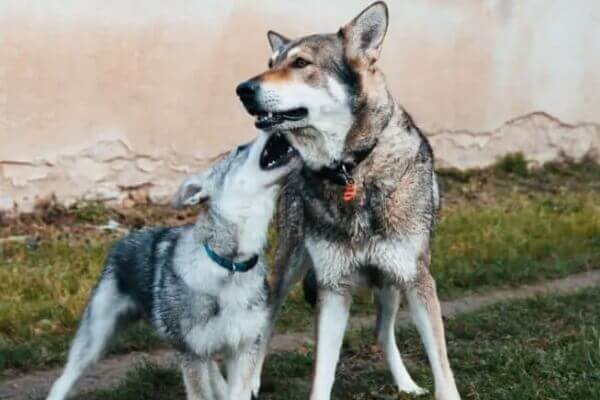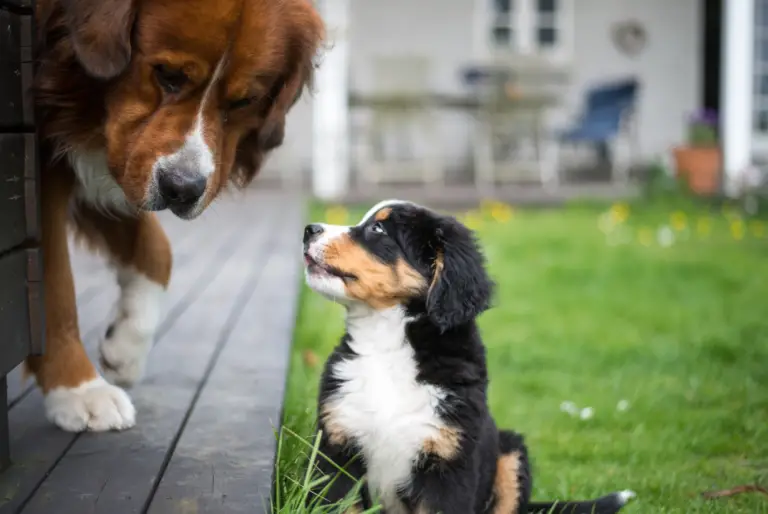Can A Dog Get Pregnant After A Few Seconds (Of Mating)? Truth Revealed!

For dog owners trying to prevent accidental breeding having a hump-happy pooch slide in for a few seconds can be worrisome. On the other hand, breeders looking to carry out successful mating may be concerned about the decreased chance of conception. But can dogs get pregnant after a few seconds of mating?
As long as the bitch is in heat, there is a possibility of pregnancy even if the mating lasts for only a few seconds. However, the success rate of this type of mating is much lower as sperm release typically begins 15 to 30 seconds after penetration.
When there is no formation of a copulatory tie before separation, it is known as slip mating. This is generally less successful because the sperm is usually poured out into the environment resulting in wastage. Other factors also affect the success rate of mating like the quality of the sperm and egg, the health condition, and the age of both the male and female counterparts.
Jump to Section
How Does Mating Work In Dogs?
Successful mating depends on the experience and personality of the dogs involved. It begins when the male first picks up the scent of the estrous female (the odor can travel a great distance).
When in contact with the estrous female, males display varied amounts of individual differences. Some display apparent indifference, some give varied amounts of attention, and increased amount of activities leading to sniffing of the female dog’s vulva. During heat, the female bitch is receptive, she will pull her tail to one side which is known as “flagging”
Mounting of the estrous female most times occurs from the rear. A single or several mounting attempts can be made. After a successful mount, the male pulls the forelimbs backward in a behavior called clasping which prevents the female from crouching or moving away.
As soon as the male has secured the female, the pelvic thrust begins and the glans penis enters the vulva. Intromission is successful in 50-60% of mounts. Once intromission occurs, thrusting accelerates and continues until the penis enters the female’s genital tract and the bulbus glandis enlarges. The female constrictor vestibuli muscle contracts around the bulbus glandis in a canine event, the “copulatory tie” or “lock”.
Once the tie is achieved, thrusting stops and sperm discharge occurs. There is a jerky or stepping movement of the legs of the male dogs during the ejaculatory period although it doesn’t occur in all dogs.
While the tie is maintained, the male then dismounts to one side, standing in the rear opposite the female. The copulatory tie may last for 10 to 45 minutes. After this, the dogs will separate naturally. It’s important to stop every attempt of forceful separation to avoid Injury to the reproductive tract.
Can A Dog Get Pregnant After A Few Seconds Of Mating?
While the possibility of pregnancy after only a few seconds of mating exists, the success rate is generally lower compared to instances of longer mating duration. The reason behind this is that sperm discharge in dogs typically begins 15 to 30 seconds after penetration. Therefore, if the mating lasts for only a few seconds, the male dog may not have enough time to release sperm, significantly reducing the likelihood of successful conception.
This scenario is often seen in ‘slip mating‘, where the male dog dismounts before the ‘copulatory tie’ is formed. Despite the lack of a tie, sperm may have been transferred, but the chance of pregnancy is generally lower due to potential spillage of sperm.
The pre-coital, coital, and post-coital phases indeed exist in all mating encounters, including instances of brief mating or ‘slip mating’. However, the duration and characteristics of these stages may vary significantly depending on whether a copulatory tie forms.
The pre-coital phase remains relatively unchanged. It begins with the male dog showing interest in the female dog, typically because she is in heat. The male will exhibit behaviors such as sniffing, licking, and mounting without penetration. If the female dog is receptive, she will position herself to facilitate the coital phase.
The coital phase involves penetration and release of sperm. In instances of a brief slip mating encounter, the coital phase is markedly shorter, with the male dog dismounting before or just after sperm discharge begins. Dismounting before a tie is known as ‘slip mating’. Despite the brevity of the coital phase, some sperm may still be transferred, meaning pregnancy is a possibility, albeit less likely compared to scenarios involving a copulatory tie.
During the post-coital phase, the dogs separate after intromission. In slip mating, the post-coital phase begins about 60 seconds after penetration. However, if there is a copulatory tie, the dogs remain ‘tied’ together for a period extending from 10 to 45 minutes.
How To Prevent Accidental Breeding (Mating) In Dogs
Not many things tugs at the human heartstrings like a group of happy pooches living together. However, there is a chance of unplanned or accidental breeding in this setting, and for young dams, this may pose potential health risks.
Unlike the case of humans that take various forms of birth control, dogs have no approved contraceptive, and certain drugs that can alter the estrous cycle in female dogs often have serious adverse effects and are not recommended for dogs. So to prevent mating, there are several tips dog owners can apply:
1. Separation During the Heat Cycle
A fundamental understanding of a female dog’s normal estrous cycle is crucial. When a female dog, or a bitch, is in heat, she will attract male dogs. To prevent unwanted breeding, consider creating a physical barrier between the sexes. This strategy relies on vigilant monitoring and may require moving the female to a separate room or enclosure to inhibit contact with males. Effective use of this method can ensure that the male’s attention is deterred, preventing accidental mating.
2. Utilization of Dog Diapers or Wraps
These accessories are designed to control the mess associated with a female dog in heat, but they can also serve as a physical barrier to breeding. The type of diaper or wrap depends on the dog’s size, breed, and personality. However, this method requires ongoing supervision as determined dogs may find a way around these barriers if left unattended.
3. Use Of Chemical Substances
Substances like chlorophyll because of it’s physiological properties helps to mask the odour of heat. Other scent elimination spray products and essential oils can be used. Although this method is not fireproof therefore care must be taken to avoid overdose
4. Vasectomy And Tubal Ligation
Sterilization alternatives such as tubal ligation (tubectomy) for female dogs and vasectomies for males can be considered if you prefer to avoid traditional spaying and neutering.
These procedures effectively prevent pregnancy while keeping the reproductive organs intact. However, not all veterinarians may offer these options, so it’s important to consult with multiple veterinarians who have experience with these procedures. They can provide more specific information regarding feasibility, cost, and availability in your area.
Finding a veterinarian who respects your choices and can provide the appropriate surgical care for your dogs is crucial.
Also: Do Dogs Still Bleed After Mating? Everything You Need To Know
How many times should a dog mate get pregnant?
Remarkably, up to 40% of female dogs can become pregnant after just a single mating encounter. That means that it will take 2 to 3 mating sessions for dogs to conceive.
To increase the chances of successful fertilization and reduce any potential stress for the female dog, a common recommendation is to allow mating to occur over a span of two to three consecutive days.
As responsible pet owners, it is paramount to understand the canine reproductive cycle. Whether you aim for successful breeding or wish to prevent unplanned pregnancies, being knowledgeable about these factors is crucial.
It’s always a good idea to consult with a professional veterinarian when making decisions related to your dog’s reproductive health to ensure the best possible outcomes for both the mother and her potential offspring.
How Can You Prevent Pregnancy In Dogs After Mating?
There are many ways to terminate pregnancy in dogs but it’s important to consult your veterinarian before making a final decision. Some of the tried and true ways include
- Spaying/Neutering: This is the most common birth control method, especially for pet dogs. An operation known as ovariohysterectomy is performed i.e. the ovaries and uterus are surgically removed.
- Mismate or Misalliance Treatment: This is the procedure that involves injecting Alizin into the dog’s neck. Two shots of Alizin represses progesterone receptors in a dog’s uterus crippling it. If you decide to use this method remember to consult your veterinarian
- Use of Dexamethasone: This is an immunosuppressant that when administered can result in painless abortions.
- Injectable Estrogen: This can be administered as skin patches and usually has fewer side effects. It’s given as soon as mating occurs
- Prostaglandin F2 Alpha: This is a natural hormone that increases oxytocin levels within the uterus. After injection, the dogs should be observed for trembling, nausea, and diarrhea. Panting or shortness of breath may also occur.
- Dopamine Agonists: This functions by inhibiting prolactin, a hormone responsible for maintaining pregnancy causing an end to your dog’s pregnancy. It is usually taken orally after 25 days of gestation
Can Dogs Get Pregnant Without Tying?
Yes, dogs can get pregnant without a ‘copulatory tie’ or ‘locking’, a scenario often referred to as ‘slip mating’. Although the chances are lower, some sperm may still be transferred during this brief encounter, making pregnancy possible. In such cases, confirmation of pregnancy can’t be determined immediately.
Around 19 days post-ovulation, an ultrasound or blood test can detect a fetus. For earlier indicators, a vet can perform a vaginal swab within a day or two after mating to check for the presence of live sperm. While this doesn’t definitively confirm pregnancy, it suggests the potential for conception.
In conclusion, dogs are individuals with varying reproductive behaviors, so even a brief mating encounter can potentially lead to pregnancy.
What to expect from a female dog after mating
Apart from other salient signs of mating, pregnancy is the most obvious sign of mating. This typically becomes prominent around the 35-40 days of pregnancy. Just as pregnancy comes with a lot of changes both physically, emotionally, and otherwise for humans, it is so in dogs. These changes include
- A slight mucus discharge around two to three weeks after mating
- Weight gain or swollen abdomen: As pregnancy progresses, intra-abdominal pressure increases leading to weight gain around 35 days of pregnancy
- Enlarged and discolored nipples: The female bitch teats become more prominent in color and size around 30 days after mating and may produce a semi-clear fluid
- Decreased appetite and activity: She may start acting quieter than usual and may lose her appetite for food. You can consult your Vet if you are concerned
- Unusual behaviors due to mood swings: Similar to pregnant women’s”morning sickness”, your dog may vomit a little at the early stage of pregnancy and may become aggressive towards you and other dogs
- Nesting behavior: This includes tearing clothes, papers, or other materials before gathering them in one place to form a “nest”
- Increased appetite will kick in during the second half of pregnancy
Final Thoughts
Dogs are capable of getting pregnant within just a few seconds of mating due to the rapid sperm release. This presents a challenge for dog owners, particularly when an unintended pregnancy occurs. Such circumstances often result from an accidental encounter during the female dog’s heat cycle, which usually occurs twice or thrice annually depending on her breed and size.
During this period, the female dog secretes pheromones to attract males, significantly increasing the likelihood of mating. The swift process, potentially lasting between 30 to 80 seconds, can result in successful fertilization and, consequently, an unplanned pregnancy.
As pet owners, it’s crucial to understand this process and manage it effectively to avoid unexpected litter. One common preventive measure is spaying the female dog, an action particularly advised for non-breeders. This procedure not only prevents unwanted pregnancies but also mitigates the associated emotional and mental stress on both the dog and its owner.
In essence, even though our canine friends can’t necessarily control when they become pregnant, we as responsible owners can step in and provide the necessary interventions. By doing so, we contribute to the well-being of our pets while ensuring we’re prepared to welcome any new puppies into the world when the time is right.
Related Articles
Read related posts about





